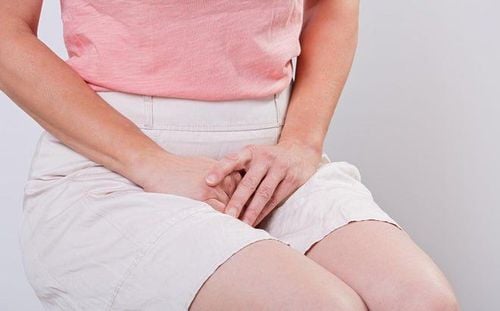Gynoflor is a vaginal tablet that works to restore lactobacillus bacteria in the vagina, and at the same time, it helps to improve atrophic vaginitis, bacterial vaginal discharge and prevent the recurrence of vaginal infections. religion. Before and during the use of Gynoflor, you need to consult your doctor carefully and use the medicine exactly as prescribed to achieve optimal results.
1. What is Gynoflor?
Gynoflor is a vaginal suppository, primarily used to restore the number of Lactobacillus acidophilus bacteria in the vagina, treat vaginal atrophy caused by estrogen hormone deficiency, vaginal discharge due to bacteria / Candida fungus, and prevent recurrent vaginal infections in women. Gynoflor suppositories are produced by Haupt Pharma and belong to the gynecological medicine group, with packaging options of 1 blister pack x 6 suppositories or 2 blister packs x 6 suppositories, containing the following active ingredients:
- Approximately 100 million live Lactobacillus acidophilus bacteria
- Estriol active ingredient with a concentration of 0.03mg.
- Other excipients sufficient for one suppository: Microcrystalline cellulose, Anhydrous disodium phosphate, Lactose monohydrate, Magnesium stearate, and Sodium glycolate starch.
2. What does Gynoflor do?
2.1 Indications for using Gynoflor
Gynoflor suppositories are commonly prescribed by doctors for the following specific cases:
- Restoration of Lactobacillus bacteria in the vagina after systemic or localized treatment with chemotherapy and some antibiotics.
- Treatment of vaginal atrophy caused by estrogen hormone deficiency in postmenopausal women / after menopause, or those undergoing hormone replacement therapy (HRT).
- Vaginal discharge of unknown origin or vaginal diseases caused by bacteria, Candida vaginal infections from mild to moderate (no need for antibiotic therapy).
- Gynoflor is additionally prescribed to prevent high-risk recurrence of vaginal infections.
2.2 Mechanism of action and benefits of Gynoflor
The main ingredient Lactobacillus acidophilus in Gynoflor is a probiotic that plays an essential role in keeping the female vagina healthy. These microorganisms are non-pathogenic bacteria that typically ferment glycogen stored in the vaginal epithelium to convert it into lactic acid. By creating an acidic environment with a pH of 3.8 – 4.5, they inhibit the colonization and growth of harmful bacteria, while also promoting the growth of Lactobacillus probiotics. Furthermore, Lactobacillus acidophilus stimulates the production of hydrogen peroxide and bacteriocin – substances that suppress the growth of pathogens in the female vagina.
Another active ingredient in Gynoflor suppositories is estriol – a hormone that acts similarly to estrogen in females. This ingredient has a specific effect on the vagina but does not affect the uterine lining. In Gynoflor, estriol helps ensure the growth and development of vaginal epithelial tissue, creating a natural protective barrier and reserving the necessary glycogen for Lactobacillus.
Exogenous estriol, when used in low doses, also promotes healthy growth and development of the vaginal epithelium. This provides optimal conditions for restoring Lactobacillus probiotics in the female vagina.
The treatment concept of Gynoflor is based on the ability to restore vaginal probiotics through exogenous Lactobacillus and improve the growth and maturation of vaginal epithelium through exogenous estriol. This leads to the re-establishment of a physiological balance for the bacteria living in the vaginal environment and the vaginal epithelium.
Research indicates that the active ingredients estriol and Lactobacillus acidophilus in Gynoflor suppositories are most effective when applied directly to the female vagina. Since Lactobacillus is a natural probiotic in the body, it is fully absorbed. As for estriol, it remains biologically inactive when excreted through urine.
3. Dosage and usage of Gynoflor
3.1. Dosage of Gynoflor
The dosage of Gynoflor vaginal suppositories will be determined based on the primary treatment goal and the patient's condition, specifically:
- For restoring vaginal microorganisms, abnormal vaginal discharge of unknown cause, and mild to moderate vaginal infections: Insert 1 – 2
- Gynoflor suppositories per day, continuously for 6 – 12 days.
For treating vaginal atrophy: Insert 1 Gynoflor suppository per day for 6 – 12 days, then maintain with 1 suppository every 1 – 2 days per week.
3.2 How to use Gynoflor
Gynoflor works best when inserted deeply into the vagina, ideally before going to sleep in the evening. Below are the guidelines for proper use of Gynoflor suppositories:
- When inserting the suppository, lie down with your legs slightly bent.
- If the vagina is dry, you can moisten the suppository before inserting it.
- You may use a pad or sanitary napkin when inserting Gynoflor.
Since Gynoflor contains excipients that do not completely dissolve, you may notice some medication residue on your underwear. This is normal and does not affect the effectiveness of the medication. Additionally, during treatment, you should avoid using suppositories during menstruation; wait until the period is over before continuing. Also, avoid using vaginal douches or deep vaginal irrigation during the treatment with Gynoflor.
4. What to do in case of overdose or missed dose of Gynoflor?
Missed dose of Gynoflor
Although missing a dose of Gynoflor will not cause harm, it may affect the effectiveness of treatment. To ensure effective treatment for vaginal infections, you should insert the suppositories regularly as prescribed by your doctor. If you miss a dose, insert it as soon as you remember. However, maintain at least 8 hours between doses of Gynoflor.
Overdose of Gynoflor
There have been no reports of any harm caused by an overdose of Gynoflor. However, taking more than the prescribed dose will not increase the therapeutic effectiveness and may increase the risk of unwanted side effects. Therefore, patients should only use the medication as prescribed by their doctor and avoid increasing the dose for personal treatment purposes.
5. Contraindications for using Gynoflor
Gynoflor’s effectiveness depends on the treatment goal and the patient's health condition. Below are the cases in which Gynoflor should not be used without the doctor’s approval:
- People who are allergic or hypersensitive to any of the active ingredients or excipients in Gynoflor.
- Women with estrogen-dependent tumors (malignant changes) in the uterus, breasts, or vagina.
- Women suspected of or with clear symptoms of endometritis.
- Women with unexplained vaginal bleeding.
- Adolescent girls who have not yet reached full sexual maturity.
6. Important precautions during Gynoflor treatment
6.1. Side effects of Gynoflor
While using Gynoflor suppositories, some unwanted side effects may occur and affect the patient’s health. However, most side effects occur at the treatment site and rarely affect the whole body. Below are some possible side effects of Gynoflor:
Mild itching and a burning sensation (in about 1.6% of cases), which may appear immediately after inserting the suppository.
Rarely, there may be intolerance reactions such as itching or redness at the treatment site.
If a Gynoflor suppository is accidentally swallowed, there are usually no reported side effects. If you experience an allergic reaction to any of the ingredients, stop using the medication and inform your doctor to manage the situation appropriately.
6.2. Precautions when using Gynoflor
Experts recommend that pregnant women use Gynoflor cautiously, especially during the first trimester. To avoid potential risks, you should inform your doctor about your pregnancy before deciding to use the medication.
For breastfeeding women, the use of Gynoflor is generally considered safe, and it does not affect breast milk quality or the health of the infant. However, as with any medication, breastfeeding women should consult their doctor about the benefits and risks of using Gynoflor.
6.3. Drug interactions with Gynoflor
Drug interactions may reduce the effectiveness or increase the risk of side effects. Therefore, you should inform your doctor about all the medications or products you are currently using, including over-the-counter drugs, prescribed medications, herbal products, or dietary supplements. Research indicates that Gynoflor may interact with the following:
Other antimicrobial drugs (systemic or topical): The Lactobacillus acidophilus in Gynoflor may be sensitive to some antibiotics. Co-administration of these drugs may reduce the effectiveness of Gynoflor.
Alcohol, tobacco, or food: Discuss with your doctor when using Gynoflor along with food or stimulants.
Health conditions: Inform your doctor about any health issues that may affect the treatment effectiveness of Gynoflor.
6.4. Storage conditions for Gynoflor
Gynoflor suppositories should be stored in the refrigerator at a temperature between 2 – 8°C. Patients may store the medication at room temperature for 1 – 2 weeks. Exceeding this period may significantly affect the treatment effectiveness of Gynoflor.
If you notice any signs of mold, damage, or discoloration on the suppositories, stop using them immediately and notify your doctor for appropriate disposal of the medication.
To arrange an appointment, please call HOTLINE or make your reservation directly HERE. You may also download the MyVinmec app to schedule appointments faster and manage your reservations more conveniently.













